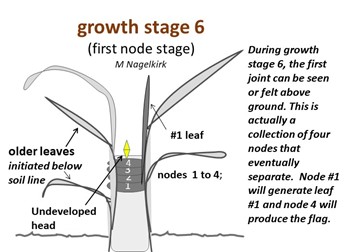Wheat growth stage 6 signals game on!
The first joint stage is a game-changer in the development and management of wheat—the plants begin to invest in their reproductive phase. The timing is right for growers to gauge their progression of management practices.

Spring is here, and with that, wheat development is progressing as expected. As you scout your fields, you might start to see your wheat crop showing its first node. That first node indicates wheat has reached Feekes Growth Stage 6. In the development of wheat, Feekes Growth Stage 6, also known as first joint, is where plants have progressed beyond the vegetative state, and the real work of producing a crop begins.
Why is this important? Everything before this point has been dedicated to laying a foundation for what begins at jointing when the plant diverts its attention to its ultimate mission: producing seed.
The rate of development for wheat depends primarily on temperature. As for calendar date, the growth stage 6 usually occurs around May 1—give or take five days—in central Michigan, a few days earlier in southern Michigan, and a few days later in northern Michigan. The date of seeding also matters. Generally, wheat sown in September may reach growth stage 6 several days ahead of a crop seeded a month later.
The best evidence of growth stage 6 is a joint (node) emerging above the soil line. This structure represents the developing head above multiple nodes. Eventually, these nodes will separate, all the while pushing the head upward. Before this, growers' management focuses on building the crop's foundation through practices primarily related to seeding and fertilization. From growth stage 6 until grain maturation, the plant is mainly growing and developing. Growers' efforts are primarily restricted to playing a defensive role to stave off potential pests, including weeds, pathogens and insects.

Perhaps the most significant advantage to identifying growth stage 6 is that it is a valuable reference to gauge the timing of various production inputs or practices. Once growth stage 6 is reached, any micronutrient deficiency should already have been addressed, and at least the bulk of the fertilizer nitrogen should have been applied. In addition, herbicides including PowerFlex HL, Osprey and growth regulator products such as 2,4-D, dicamba, MCPA and Curtail should no longer be used.
Growth stage 6 is also helpful as a reminder that the cutoff for using some other crop protection products is only one to two weeks away (again, depending on air temperatures). That is, before the end of growth stage 7 (two nodes without the flag leaf tip being visible), applications of herbicides including Affinity, Harmony, Huskie and Quelex; and the growth regulator Palisade must be completed to avoid crop injury or an off-label application.



 Print
Print Email
Email